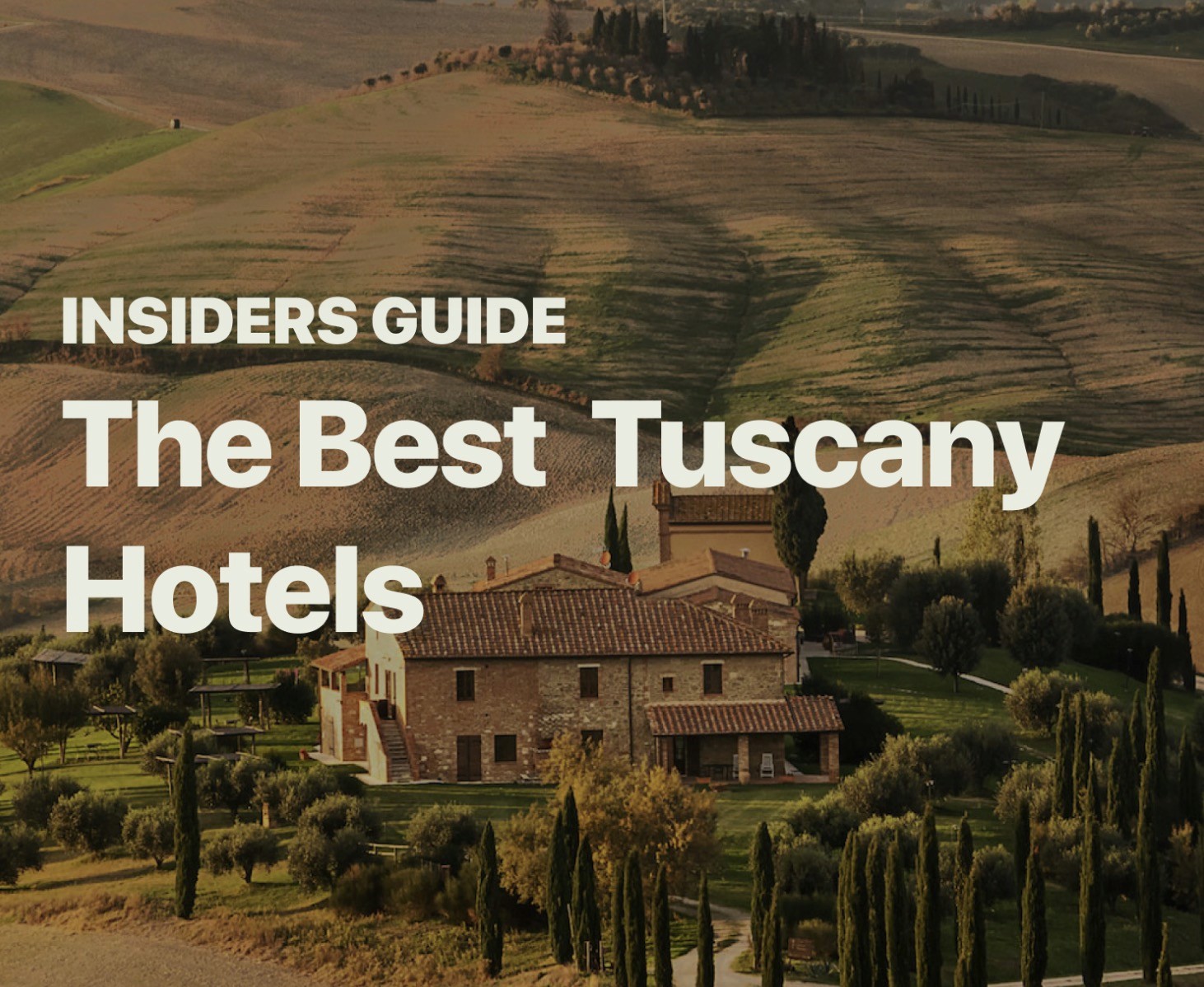Travel
Written by
Hugo Cannon
Experience Tuscany's allure: sip world-class wines amidst picturesque vineyards, see villages steeped in history, and savour exquisite cuisine that delights the taste buds. Tuscany, with its timeless beauty and rich cultural legacy, offers a memorable tour through the heart of Italy.
Table of Contents:
Tuscany, with its rolling vineyards and mediaeval towns, looks like a scene from a fairy tale, ready for you to enter its fantasy world. It's a dream destination for any wine enthusiast, with well-known wines such as Chianti and Brunello. Imagine walking through Florence's small cobblestone lanes, gazing up at towering cathedrals and palazzos. And let us not forget about the food! Tuscan cuisine is an unbelievable experience. So, why wait? Come experience the charm of Tuscany and create memories to last a lifetime.
Best Hotels in Tuscany
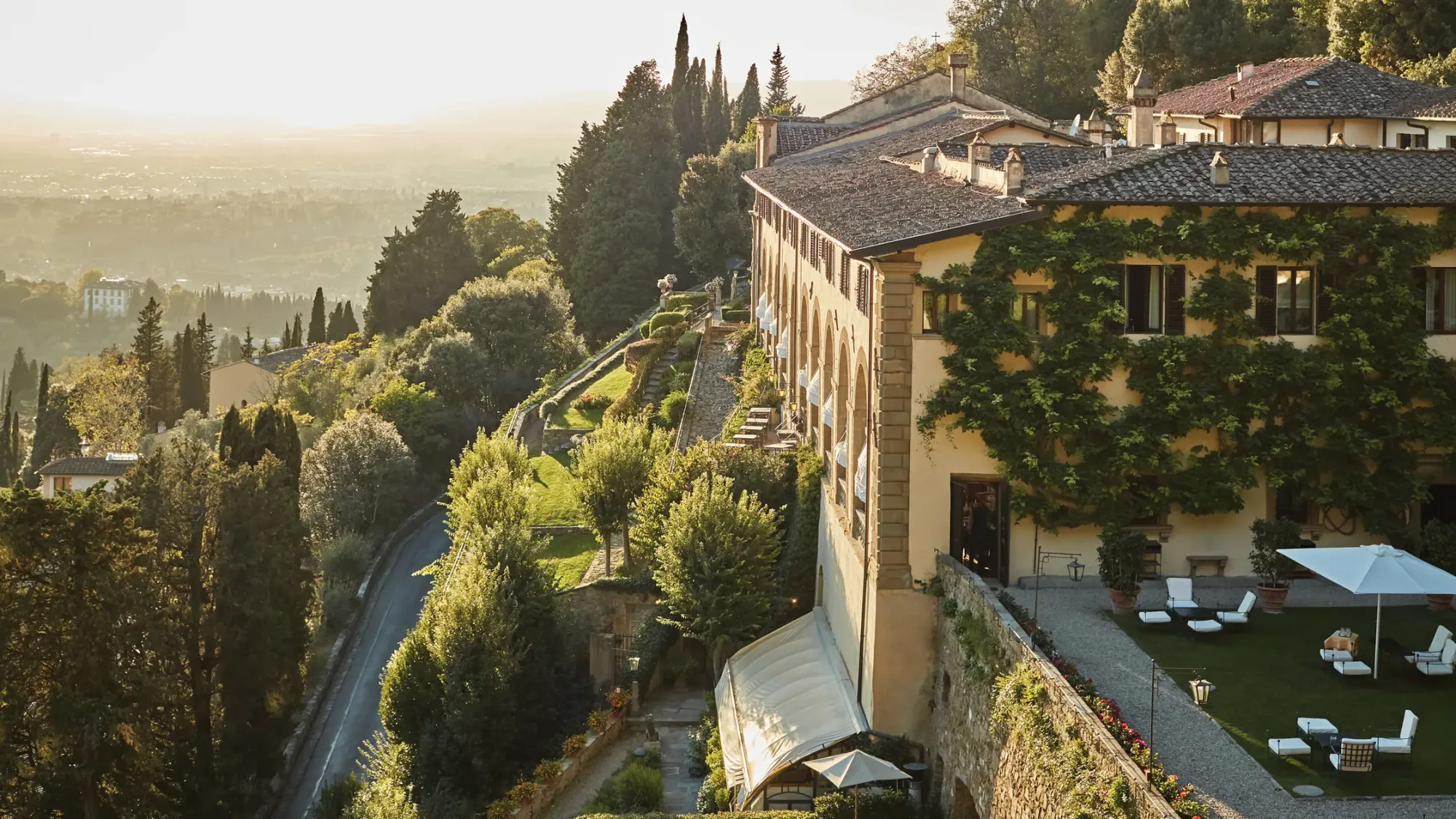
Belmond Villa San Michele
Belmond Villa San Michele
The location, on a calm, forested hillside just below the historic village of Fiesole less than five miles north of Florence's centre, gets my vote, but it's around a 20-minute drive from the main attractions. Although there is a regular shuttle service, it may not fit everyone.
However, the sweeping views of the city from the gardens, most of the rooms, the restaurant, and the pool are spectacular, and the temperature up here is several degrees cooler during the height of summer.

Belmond Villa San Michele
The hotel emphasises controlled excellent taste above ostentatious luxury, while Africa, the GM's affable labrador, keeps things from becoming too stiff. It is located in a former Franciscan monastery from the 15th century (Michelangelo is claimed to have designed the weathered, porticoed façade).
The main building, a maze of rooms, hallways and stairways, has many ancient elements, including cloisters (now covered), huge arches and vaulted ceilings, a long loggia (now the main restaurant), and aged terracotta flooring.
Precious Florentine antiques, as well as old master paintings and prints, fit nicely in the historic rooms, but a recent delicate refurbishment (with the addition of some more contemporary furniture, fresh colours, and so on) has livened things up a bit.
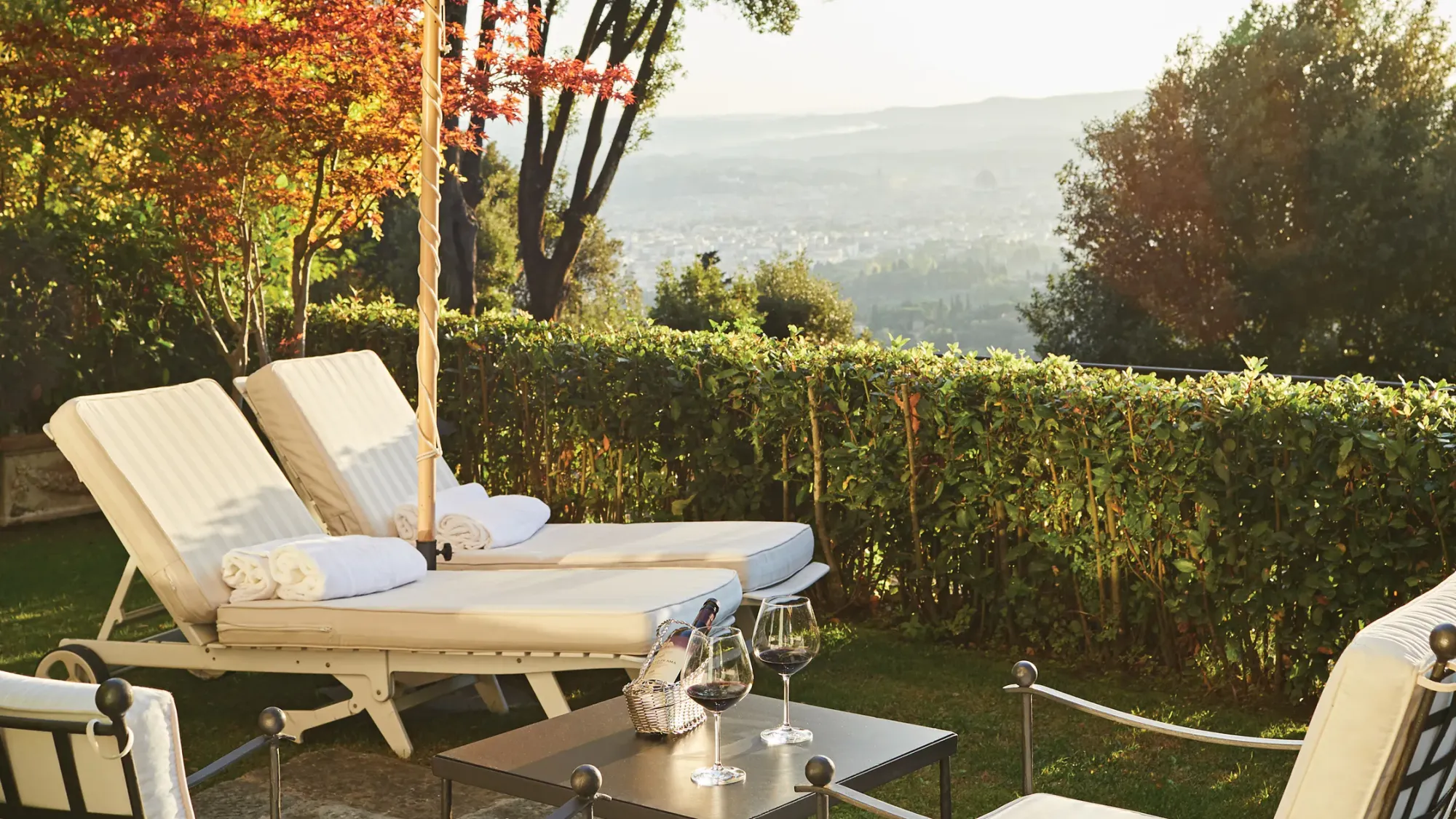
Belmond Villa San Michele
As one would expect from a Belmond hotel, the services and facilities are excellent, including a well-known cookery school. The pristine, terraced gardens are a delight, and the panoramic pool, nestled in a verdant lawn at the top of the house, is a true advantage in hot weather and almost compensates for the lack of a spa, though there is now a 'wellness room' in the villa for massages and other treatments.
The little gym is open 24 hours a day, and there is a canopy in the garden where you may get a massage with a view. Cocktail workshops, wine tastings, trips to a cashmere manufacturer in Chianti, and rafting down the Arno River are among the many activities available.
The service is old-school, attentive, and courteous, and many of the employees (who will remember your name) have been here for years. There is a high level of attention to detail, such as personalised pillow cases for'special' guests.
The 22 rooms in the main building have an appropriately ecclesiastical atmosphere, but the monks would have scowled at the amenities on offer. Expect vaulted ceilings, bottle-glass window panes, and antique furniture, including some beautiful old bedsteads.
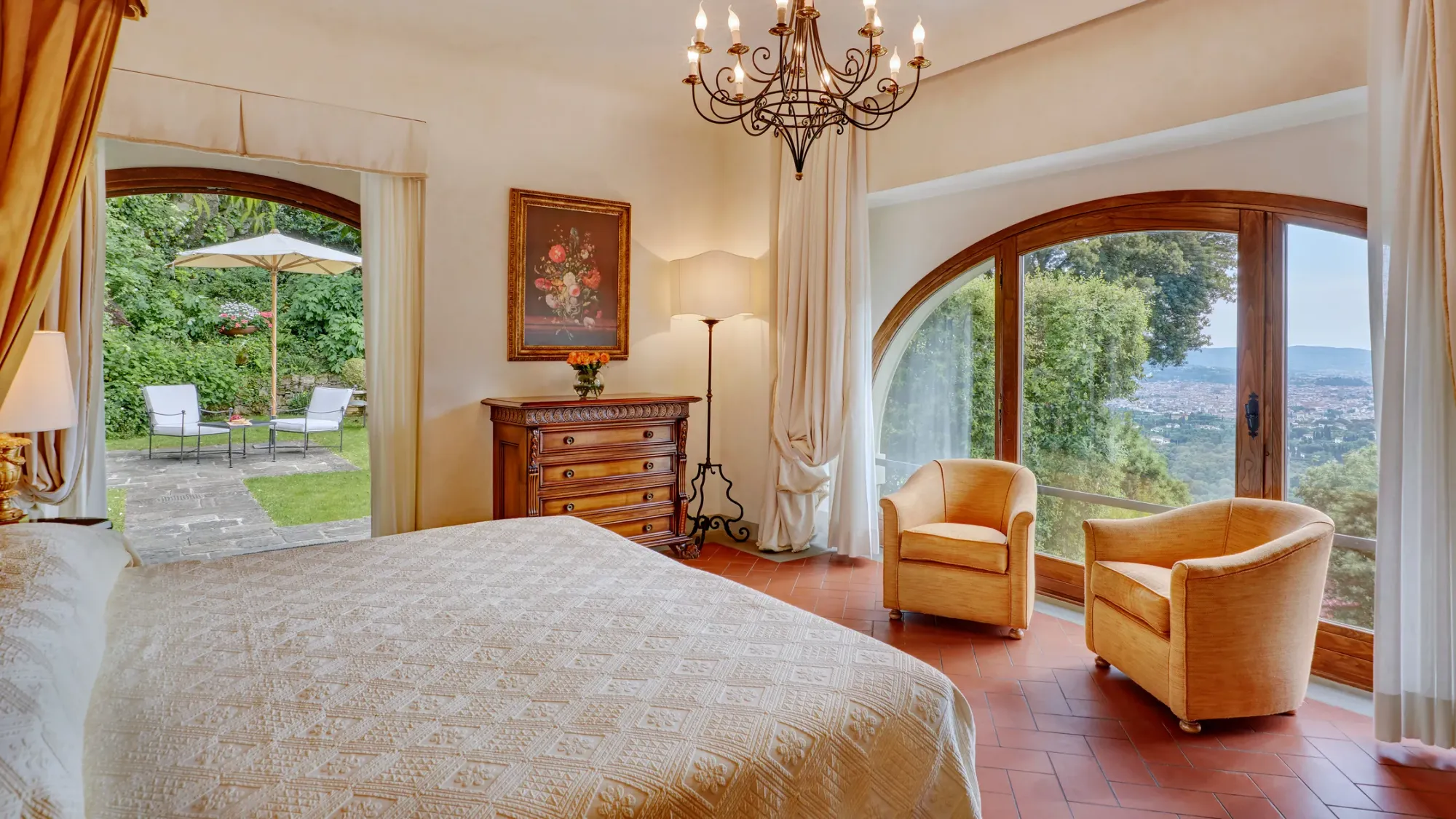
Belmond Villa San Michele
The 23 rooms in the garden annexes have less charm but greater space and large baths, and they are nonetheless exceedingly pleasant; each has a private garden of some kind. Each room has a Nespresso machine as well as tea and coffee trays.
The elegant yet lively main restaurant is housed under a long, vaulted loggia with views of the city, which is particularly spectacular at sunset.
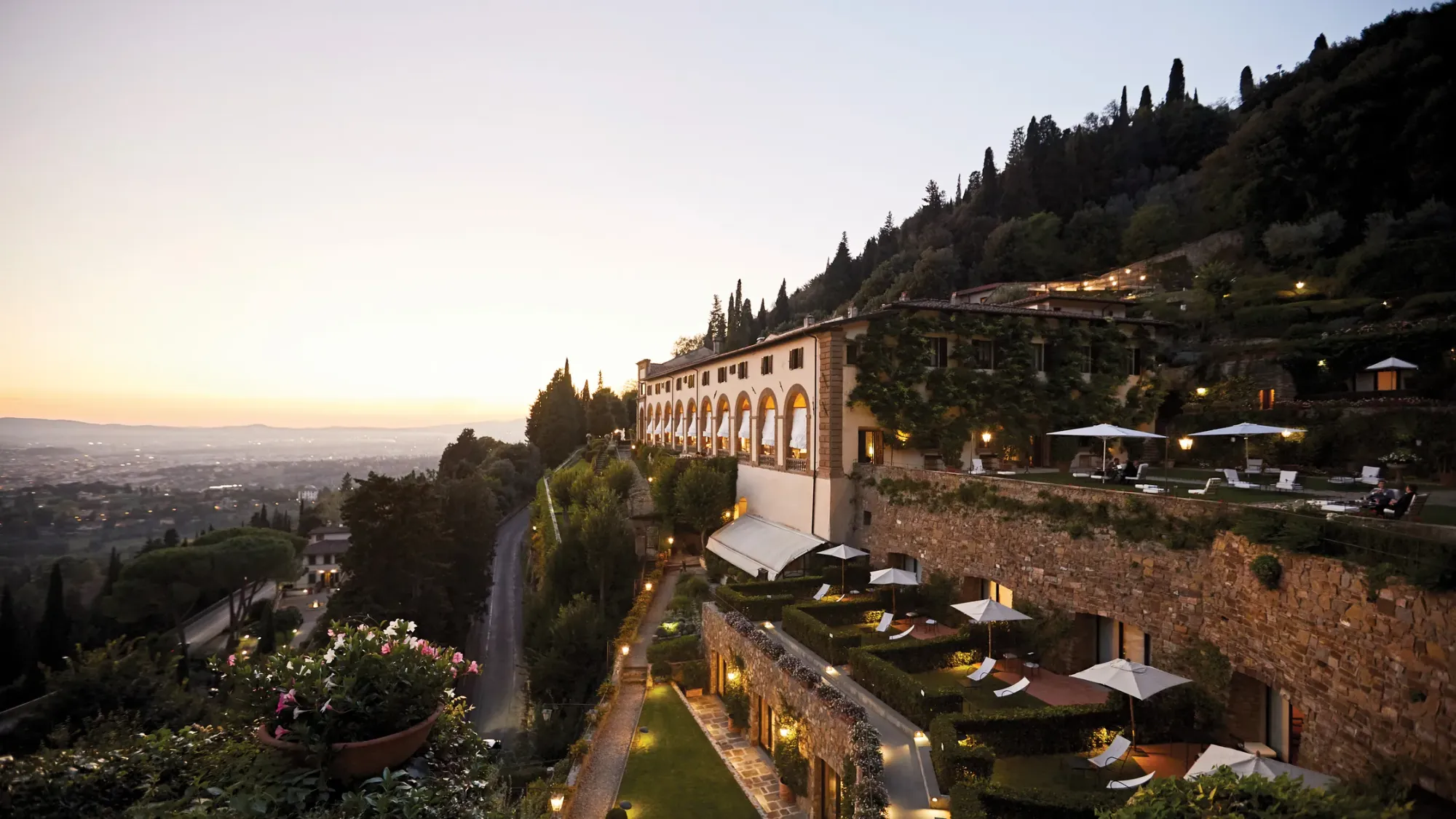
Belmond Villa San Michele
The advent of young chef Alessandro Cozzolino in April 2019 breathed new life into the formerly staid menu, which now combines parts of Tuscany and his native Campania, as well as the occasional journey into Asia and beyond, with intriguing results.
Choose from traditional panzanella bread salad with amberjack ceviche and Jerez vinegar, Florentine 'lasagnette' with delicately smoked rabbit sauce and seasoned Tuscan cheese, or seared turbot with mango.
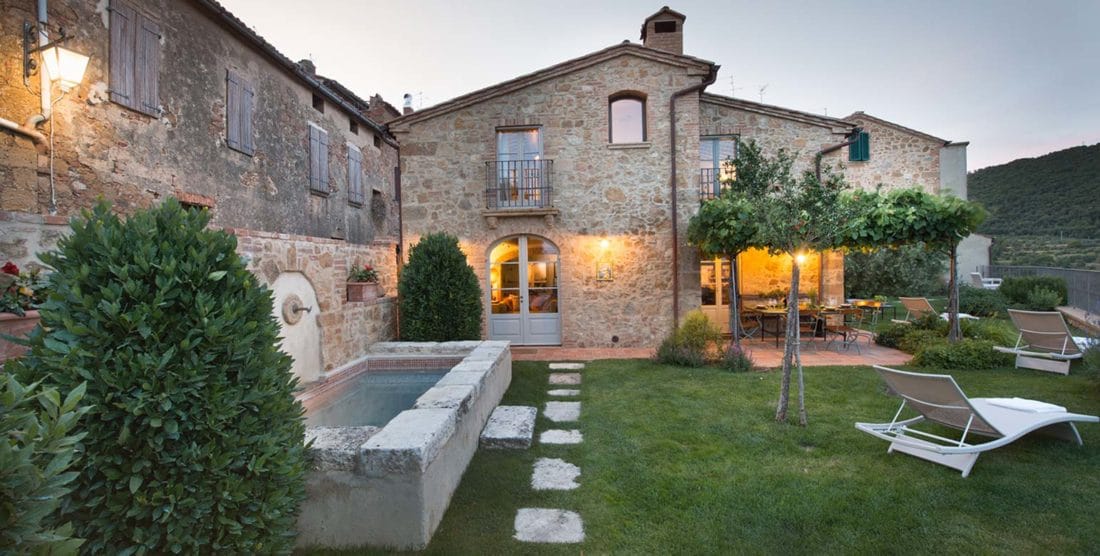
Casa Moricciani
Casa Moricciani
Castelmuzio, located on the boundary of Unesco World Heritage Site Val d'Orcia and only a 10-minute drive from Pienza, is a tiny counterpart of the famed Renaissance town (wonderful old town centre and great views), but without the swarms of visitors who accompany the former.
The village shop, bar and restaurant are all a two-minute walk from Casa Moricciani. Montisi, another picturesque village, is only a five-minute drive away. Wine aficionados could head farther afield to Montepulciano and Montalcino (30 minutes each), while Siena is an hour away.
The Italian owners had considered moving into the house themselves, and restoration work has been done with meticulous care, beginning with the recuperated wood beams and 18th-century terracotta floors (only the best would do for the former home of an Italian noble family).
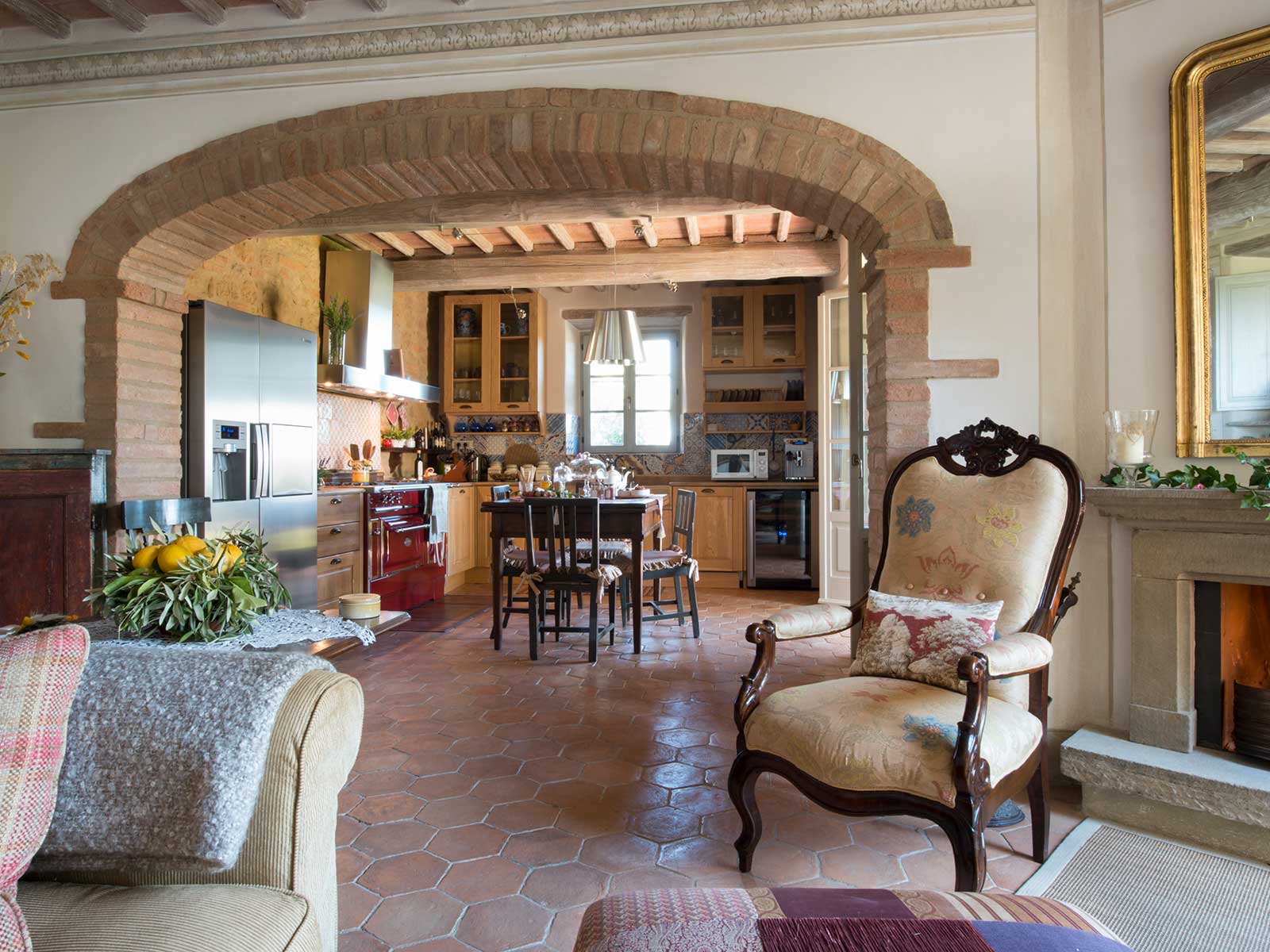
Casa Moricciani
The interiors are in warm earthy tones, with exquisite wall paintings, antique fireplaces, and fresh flowers to complete the look. The exquisite country-style kitchen features a professional French stove and antique majolica tiles. Guests will also find a wicker basket filled with ceramic dinnerware ready to be taken out for a picnic.
Isabella Barlocher worked at Campari in Milan before falling in love with Carlo Moricciani, a Tuscan farmer from Pienza. The couple's combination of local knowledge and Milanese business acumen yields an impeccable, customised concierge service.
Guided excursions and cookery sessions at the family farm are essential. Two large leather-bound binders in the property contain recommendations for sightseeing, shopping, and restaurants (together with all necessary maps and GPS information).
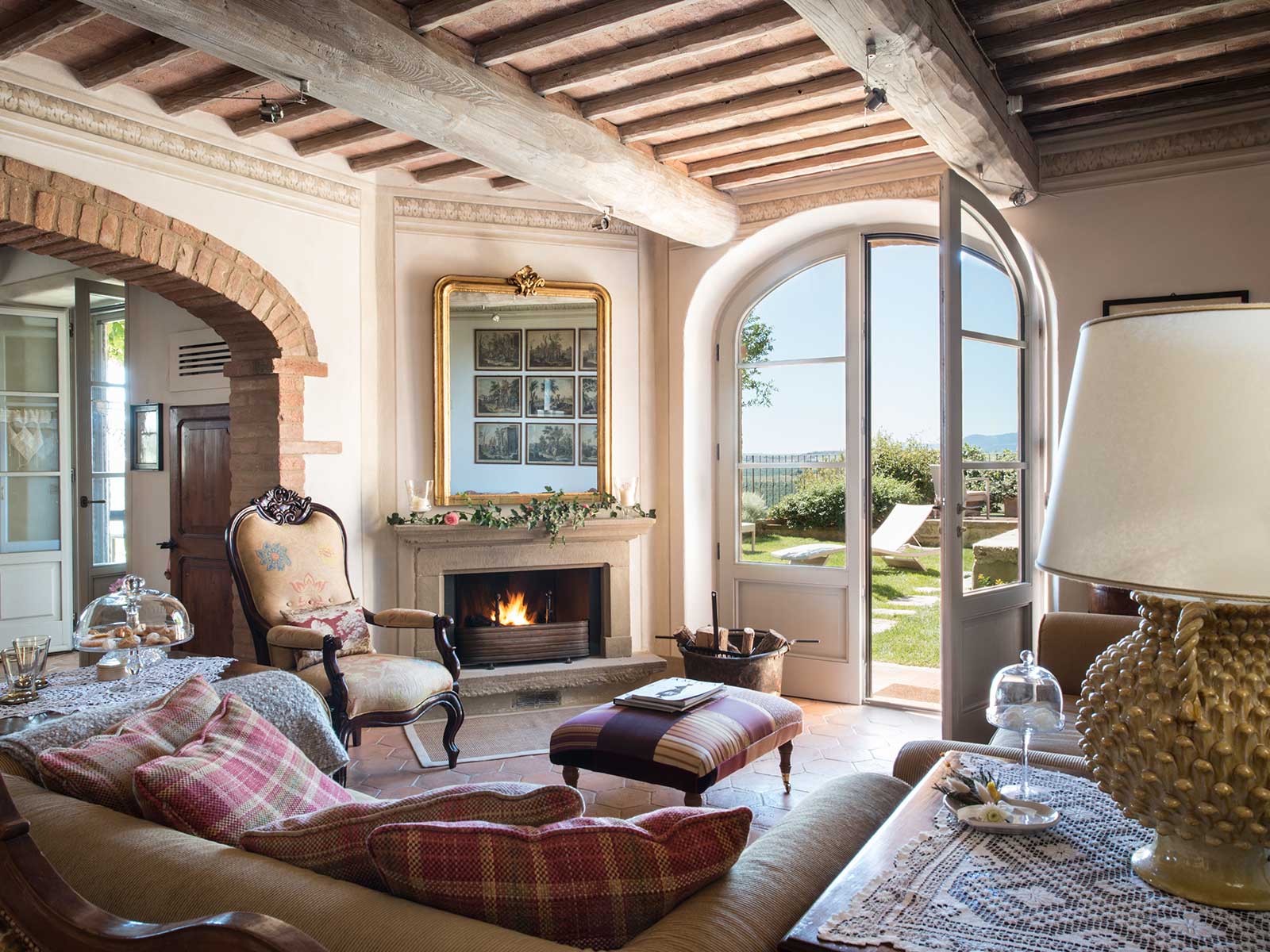
Casa Moricciani
The garden is well maintained, providing idyllic settings for al fresco eating and sunset views from beneath the pergola. The freshwater plunge pool is a perfect location to unwind with an aperitif after a long day of touring.
The four bedrooms are accessed by repaired wooden doors. Unique objects, such as the old wrought-iron bedstead, complement the home's careful traditional decor.
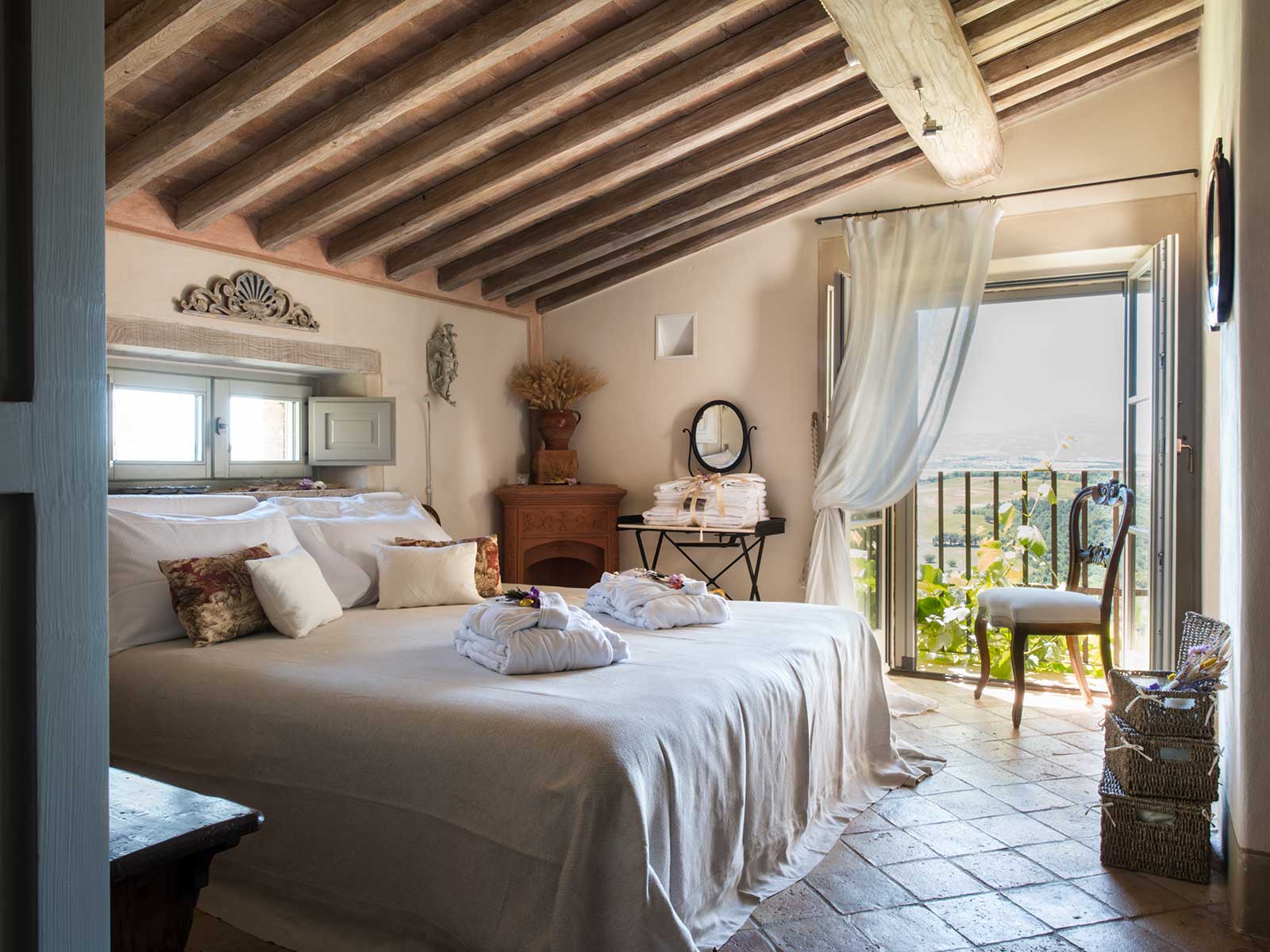
Casa Moricciani
From linen curtains to bed throws, all textiles are acquired from top labels like Milan fashion company Etro or lovingly handcrafted by local artisans.
The bathrooms have magnificent travertine sinks and tubs with whirlpools or wide rain showers (check out the spectacular valley view from the first-floor shower); hair straighteners, hair dryers and copious samples of the family-owned Locherber natural bath and skin care products are provided.

Casa Moricciani
A self-catering basket may be pre-ordered and is well worth the cost (€25/£22). Fresh fruits and vegetables are served alongside local food like pasta, homemade bread, olive oil, and red wine. The temperature-controlled wine cabinet is stocked with Brunello, Vino Nobile, and other carefully chosen local wines.
La Locanda di Casal Mustia is a restaurant, café and bar in one. Located in the village's main plaza, this is an excellent place to grab a quick coffee, aperitif, lunch, or dinner. Local chefs can provide culinary workshops and dinners right in the villa.
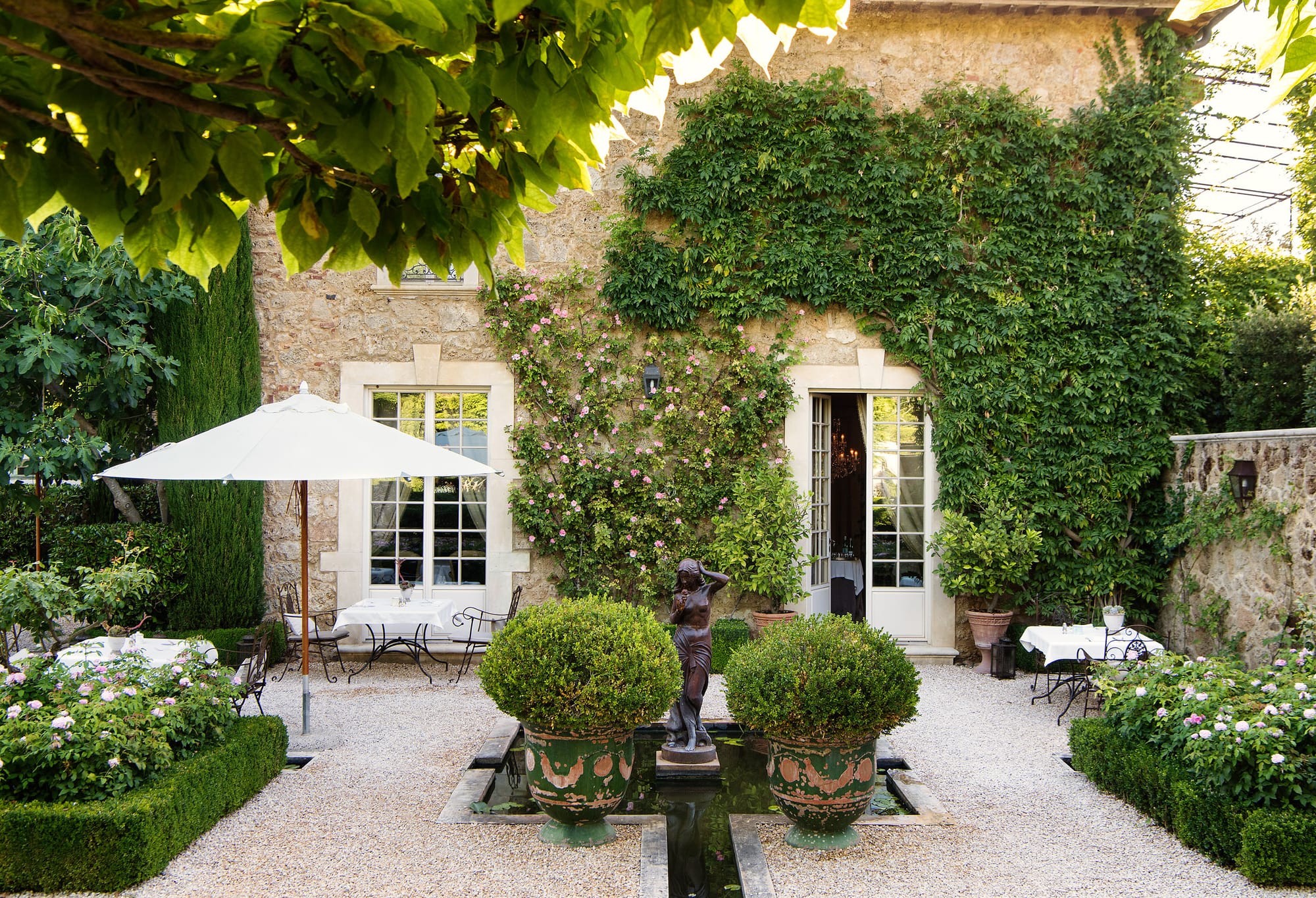
Borgo Santo Pietro
Borgo Santo Pietro
Set in lovely countryside far from the beaten track, 45 minutes southwest of Siena and near to the historic roofless abbey of San Galgano. The property spans 300 acres of gardens, farming, and woodlands, and there are numerous activities available on-site, so many tourists remain for the duration.
If you want a taste of metropolitan culture, the charming cities of Volterra, Massa Marittima, and Colle Val d'Elsa are all within an hour's drive. For beachgoers, the coast is a little further. The nearest airport is Florence Peretola (about 90 minutes by driving).
The atmosphere at this country house hotel is similar to that of a classy friend's estate. Danish co-owner Jeanette Throttrup has managed every detail of the interior design, which is luxurious and exquisite with a distinct antique feel.
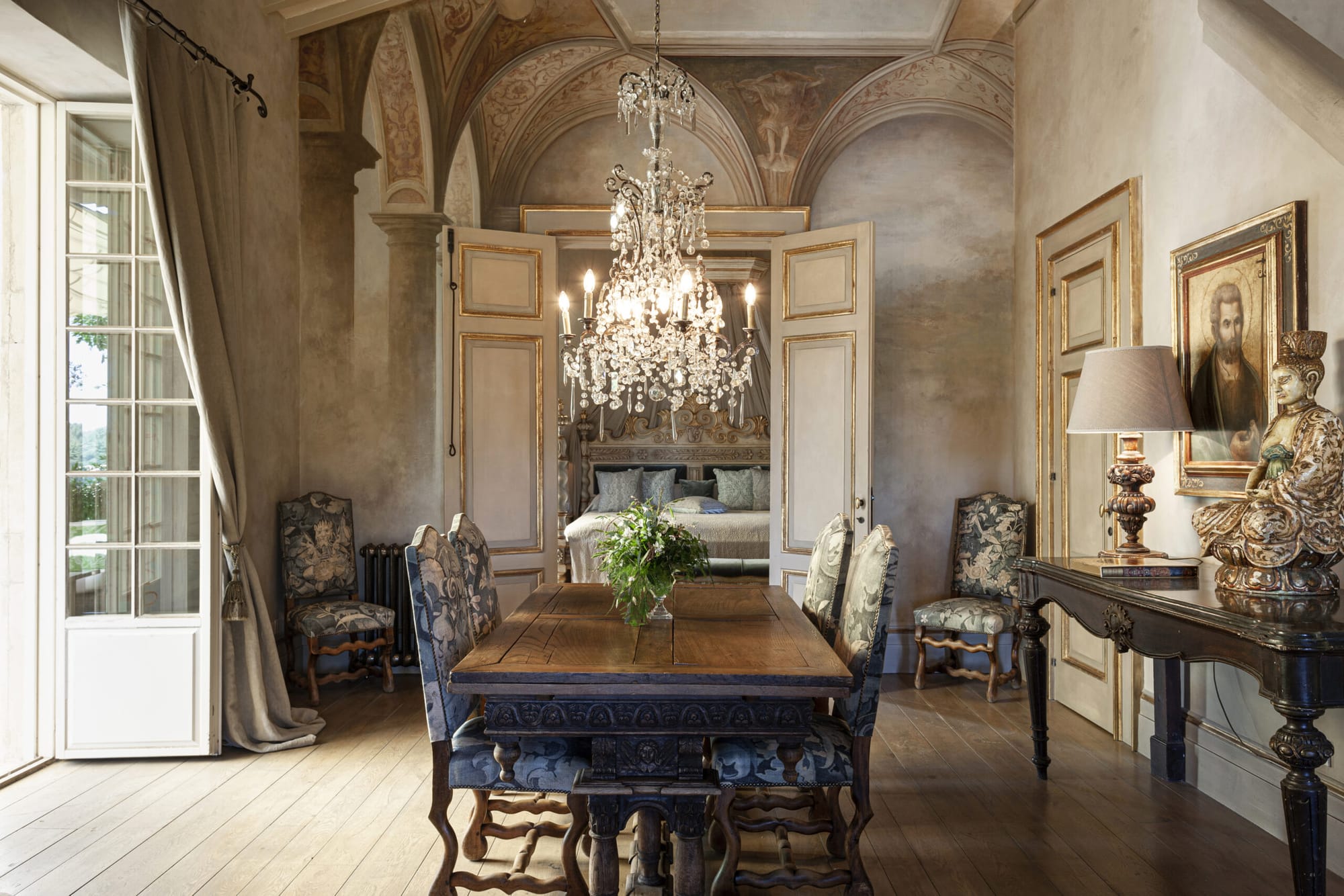
Borgo Santo Pietro
The main villa's public areas have working fireplaces (which crackle cheerfully in cool weather), rich earthy hues, leather and velvet, spectacular floral arrangements, antiques, and gilt mirrors; flickering lighting adds to the intimacy. It's a kind of Tuscan-style 'hygge'.
Although guests come here to enjoy a luxurious and exclusive country vacation (which BSP provides in spades), many leave truly amazed at the bigger picture, because the Throttrup's vision for Borgo is that it will one day be self-sufficient, and it is constantly evolving; the most recent additions include two new garden suites, a fermenting lab, a drying shed for herbs and flowers, vineyards, additional kitchen gardens, and an alpaca herd.
The extensive facilities include a fantastic spa that uses the estate's herbal Seed-to-Skin products, a stunning infinity pool, swimming in the River Merse, numerous lounging areas both inside and out, 13 acres of magnificent gardens, and two restaurants. That's not to mention the miles of hiking paths that wind across the property.
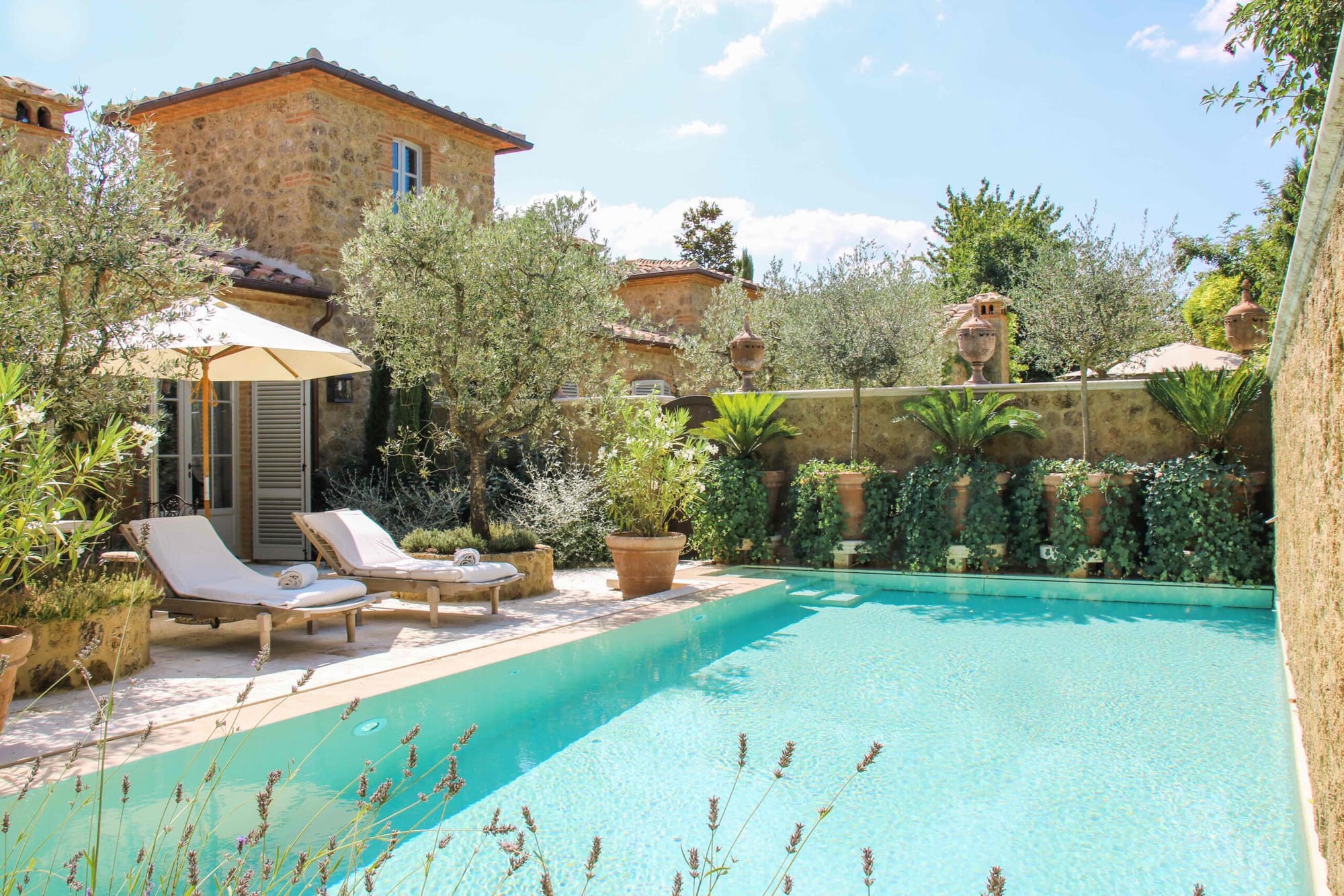
You can sign up for culinary, flower arranging, and art workshops, farm visits, beekeeping and cheese-making demonstrations, Vespa tours, and hot air balloon rides. There is a helipad and even a 41.5-metre yacht available for charter.
Pets are permitted in the garden suites (a one-time €30/£25 fee applies).
Super-helpful staff are all friendly and professional, and they will go out of their way to accommodate customers' every desire.
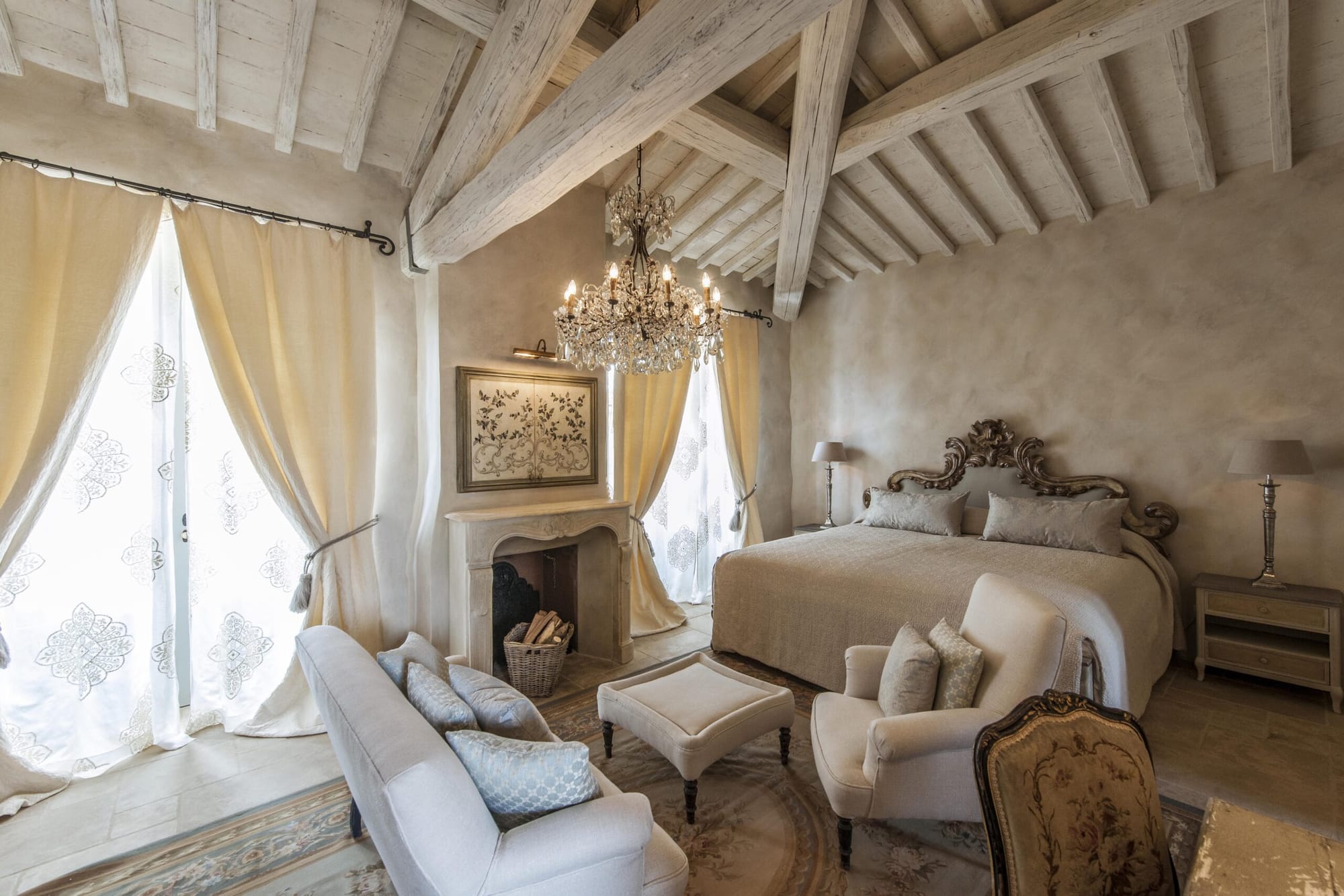
Borgo Santo Pietro
Each of the 22 bedrooms and suites is distinctive, yet they are all huge and extremely comfortable. The style is light and romantic, with vaulted ceilings and pale stone flooring, lovely paintings, antiques and dazzling chandeliers, nubbly Tuscan linens and rich velvets, and a soft, soothing colour palette. Mood lighting (managed by an unintuitive series of switches, it must be stated) and candles enhance the atmosphere.
The three massive, wonderful pool suites are the best of the group, with private pools and fireplaces both inside and out, but the garden suites are also stunning and ideal for anyone seeking isolation.
The main villa has eight rooms, including the spacious first-floor Santo Pietro Suite, which has a huge terrace and panoramic views.
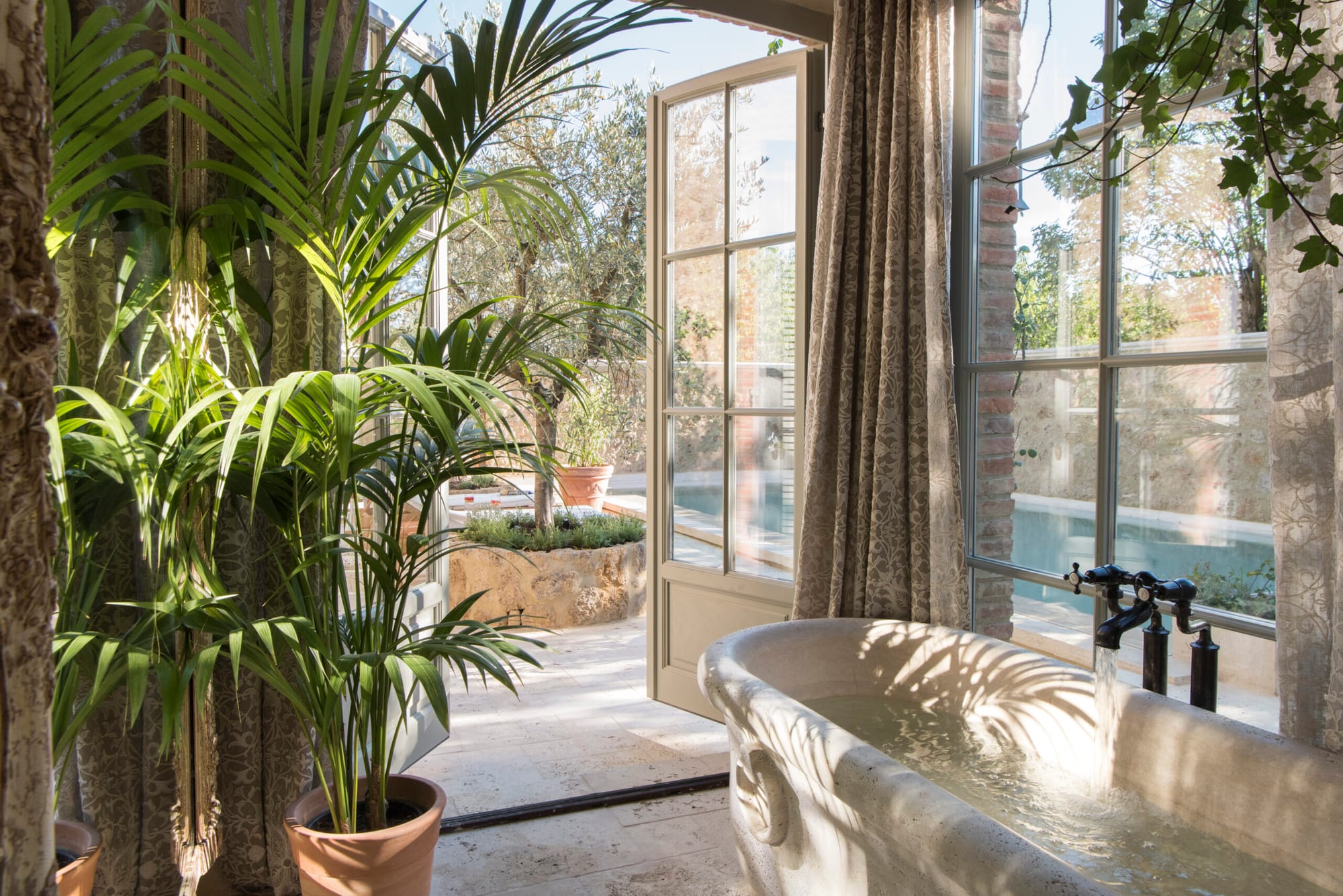
Borgo Santo Pietro
Enveloping beds have the finest Egyptian cotton sheets, feather duvets, and layers of plush pillows. Bathrooms are as fantastic as you'd hope, with honey-hued stone, double basins, big walk-in showers and claw-foot tubs, piles of fluffy towels, and generous amounts of the divine in-house Seed to Skin bath and body products.
All rooms come equipped with fully loaded iPads and DVD players, in addition to the standard flat-screen televisions.
The menus in the two restaurants are driven by a committed farm-to-table ethos; the vast kitchen garden and farm supply just-picked fruit, vegetables, and herbs, fresh eggs from the galline (who live in luxury in a row of pastel-colored coops), honey from the bees, cheeses from the sheep (processed in the in-house dairy), rabbit, fallow deer, and wild boar.
At Michelin-starred Meo Modo, where farm-to-plate is the driving idea, the chef accomplishes extraordinary things with the estate's bounty, focusing primarily on vegetables. Seafood also plays a role, with plenty of lobster, amberjack, and sea bass from the adjacent Tyrrhenian Sea.
The more casual Trattoria sul Albero is a fantastic space: a treehouse built around the enormous trunk of an ancient oak tree. Tuna tartare with guacamole, ricotta and spinach-stuffed cappelletti, grilled fish and bistecca, and delicious wood-fired pizza are all available here. The regular Monday night 'Farmer's Market' dinners with live jazz are quite popular; there is a self-serve buffet to begin, followed by meat or fish grilled to order.
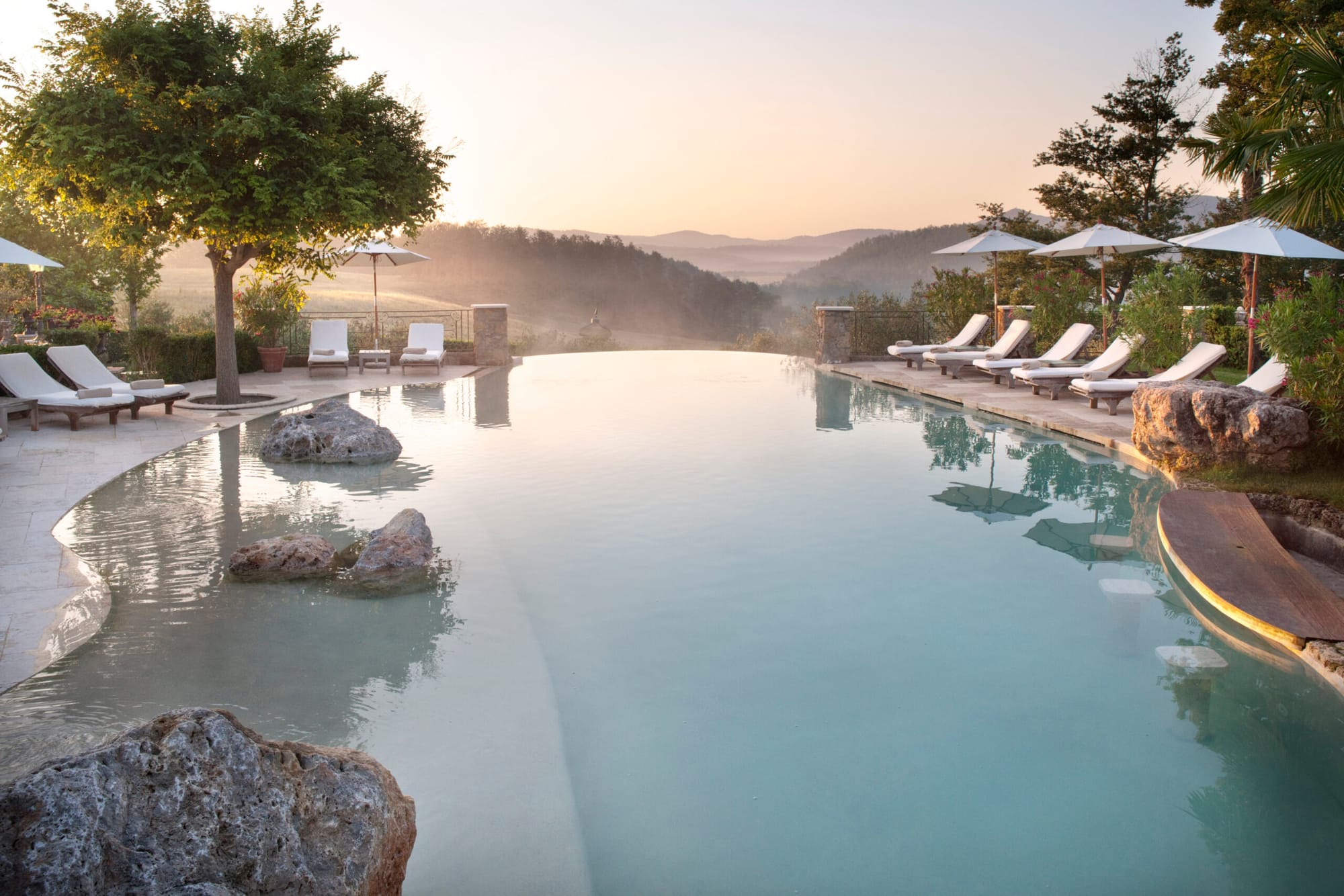
Borgo Santo Pietro
A delicious breakfast is offered until 11 a.m. (albeit it's a moveable feast); in addition to a buffet table brimming with sweet and savoury treats, staff will whip up bacon and sausage, eggs Florentine or Benedict, omelettes, pancakes any way they want at the breakfast counter.
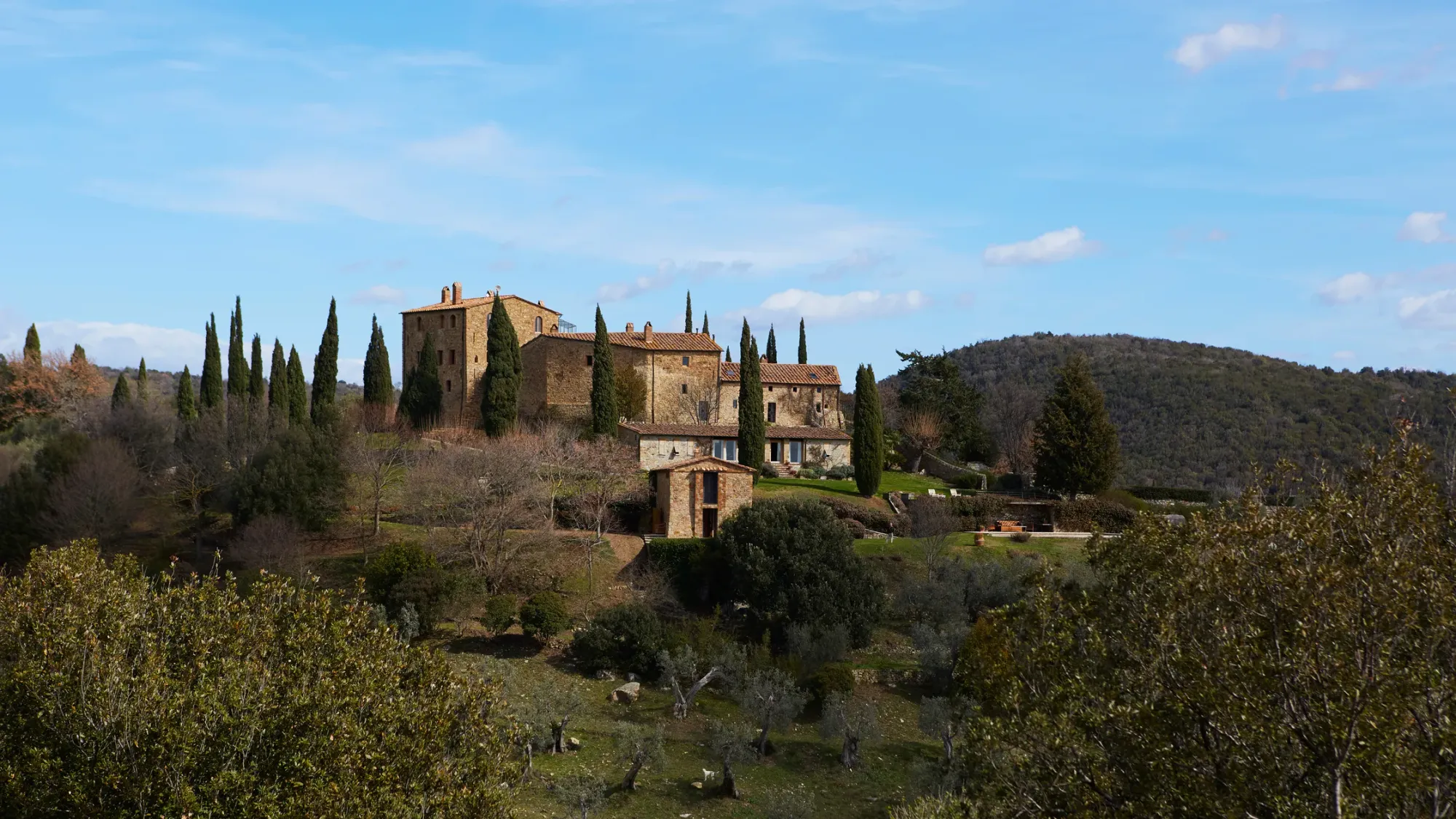
Castello di Vicarello
Castello di Vicarello
The off-the-grid location, at the end of a bumpy gravel route deep in the southern Maremma, cannot be beat if you want to entirely unplug and relax, yet there is culture within a 40-minute drive.
Rising squarely from a hilltop perch and guarded by soldier-straight cypress trees, the 12th-century stone castle and outbuildings are surrounded on all sides by the most glorious views of the Ombrone valley, with its thickly forested hills, vines, and olive trees, plus the odd stone farmhouse; the outline of Monte Argentario and a hazy strip of sea can be seen to the west.
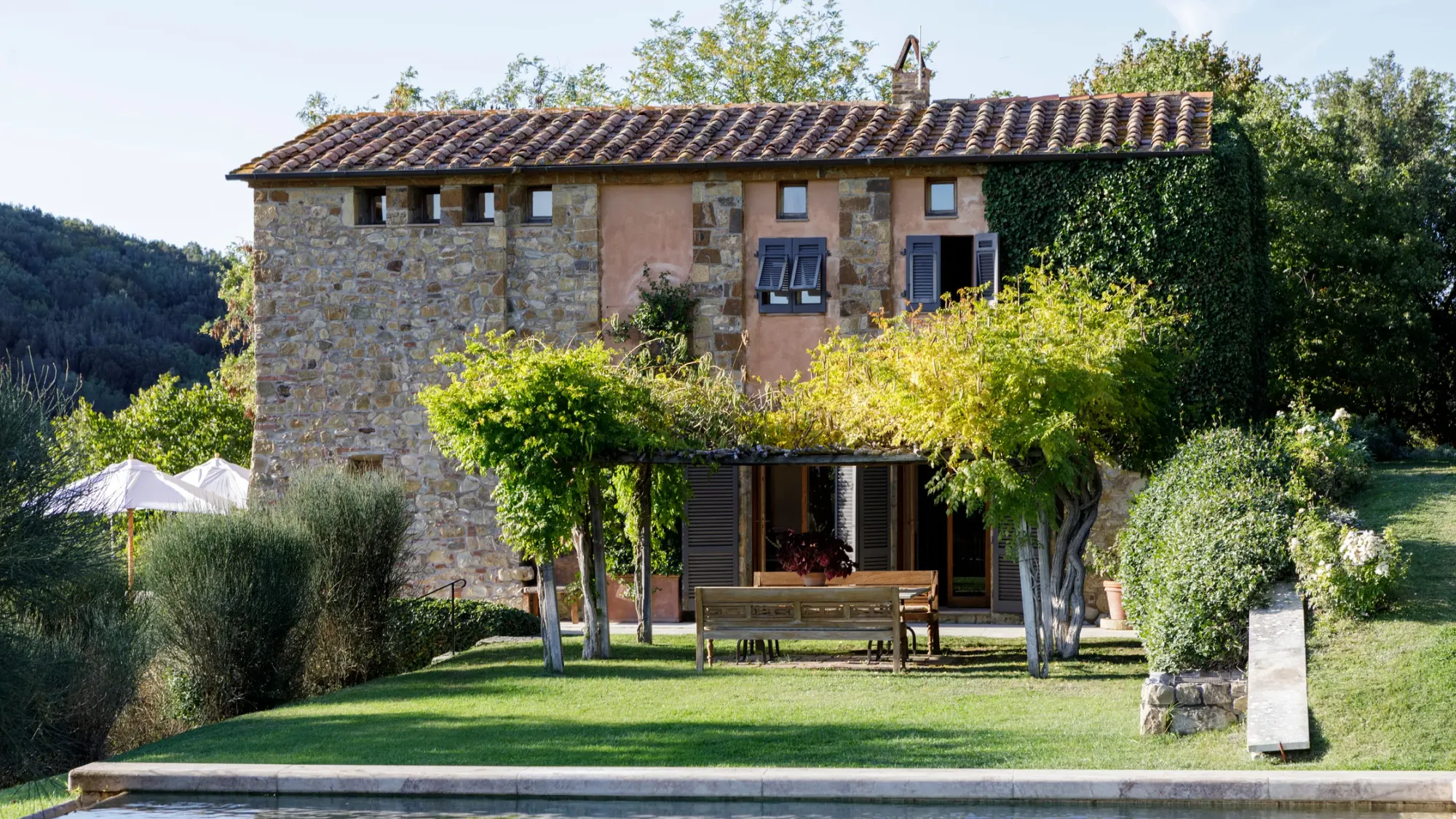
Castello di Vicarello
The little village of Cinigiano is only a 10-minute drive away, while Siena and the Argentario beaches are 40 minutes apart. The main roadway connecting Siena and Grosseto is a 20-minute trip. The nearest airport is Florence Peretola (one hour and 40 minutes by vehicle), while a train from Grosseto (a 20-minute drive) takes less than two hours to Rome.
Aurora and Carlo Baccheschi Berti purchased the wrecked castle in the 1970s and began a comprehensive repair. Initially, it served as a home for family and friends, but it was later converted into a hotel with the feel of a quirky - but extremely charming - party house.

Castello di Vicarello
Today, it is in the capable hands of their three sons, Brando, Neri, and Corso, who have improved the amenities and service while preserving the essence of this unique hideaway.
The style is eclectic and very personal: the atmospheric rooms are filled with a mix of Indonesian pieces (accumulated during the Baccheschi Berti's 20 years of living in Bali), Tuscan antiques, design classics from the 1960s and 1970s purchased at auction, and a haul of family china, glassware, paintings, oriental rugs, and curiosities. Coffee tables are piled high with books and periodicals, ideal for spending a cool afternoon in front of a roaring fire.
The charming young personnel are friendly and helpful, and they will do everything they can to ensure that your stay runs properly.
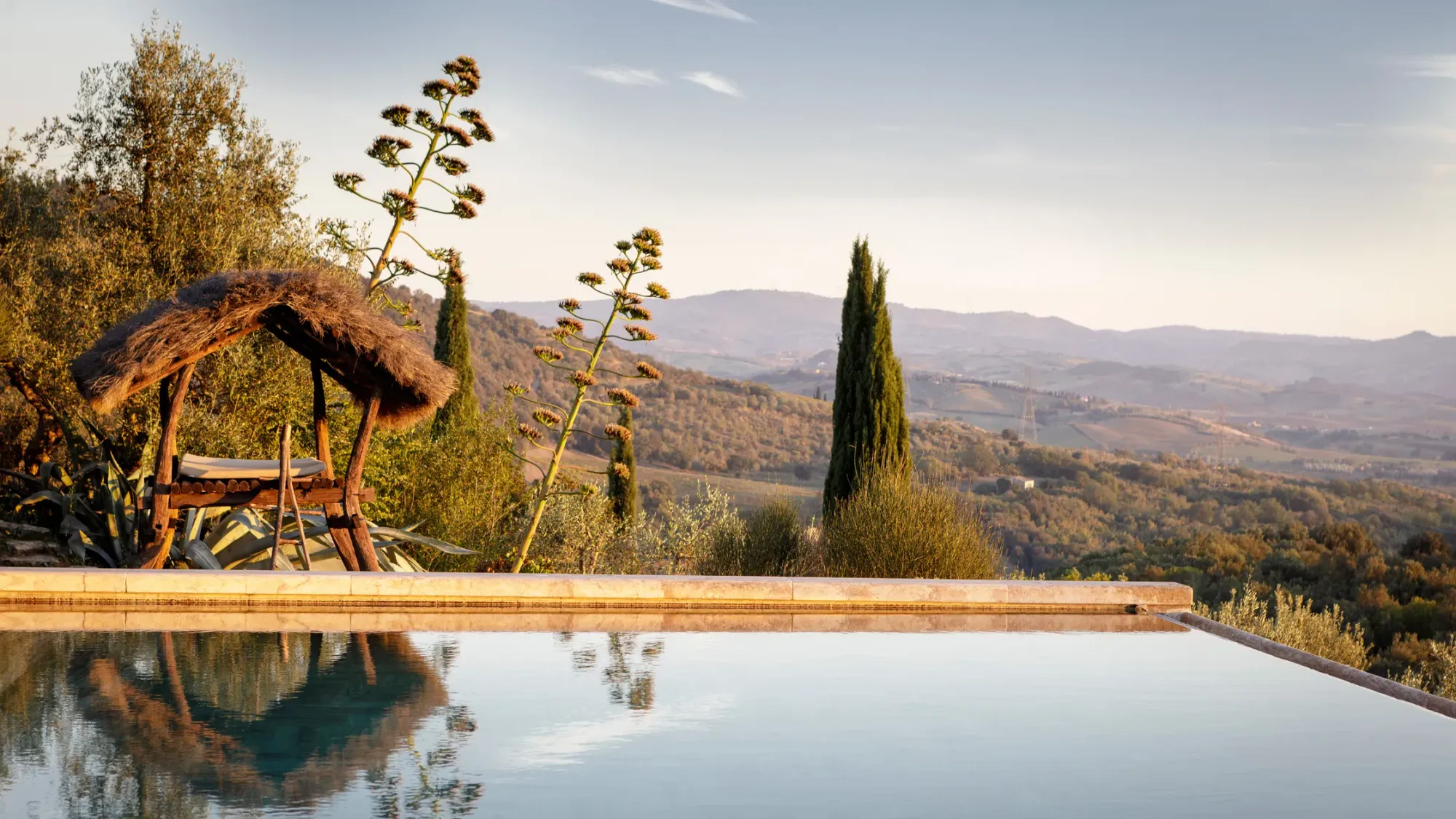
Castello di Vicarello
Uva, the soppy in-house lab mix, welcomes guests joyfully and contributes to the warm atmosphere of the establishment. Wine tastings, hands-on culinary classes, riding lessons, and leather crafts with a local artisan are among the many activities available.
Free E-bikes and a vintage Fiat 500 (for an additional fee) are available for tours throughout the countryside. For only nine suites, there is a tremendous amount of space, including lovely rambling gardens with immaculate grass, a large vegetable plot, plenty of shady, isolated seating spots, two fabulous pools (one heated) with spectacular views, and walking and bicycling trails among the wooded hills.
Among the olive trees is a wood and glass spa suite; future plans include a gym as well as a full spa with sauna and steam room.
Dogs are welcome (additional daily charge) and will be provided with a bed and a welcome pack of treats.
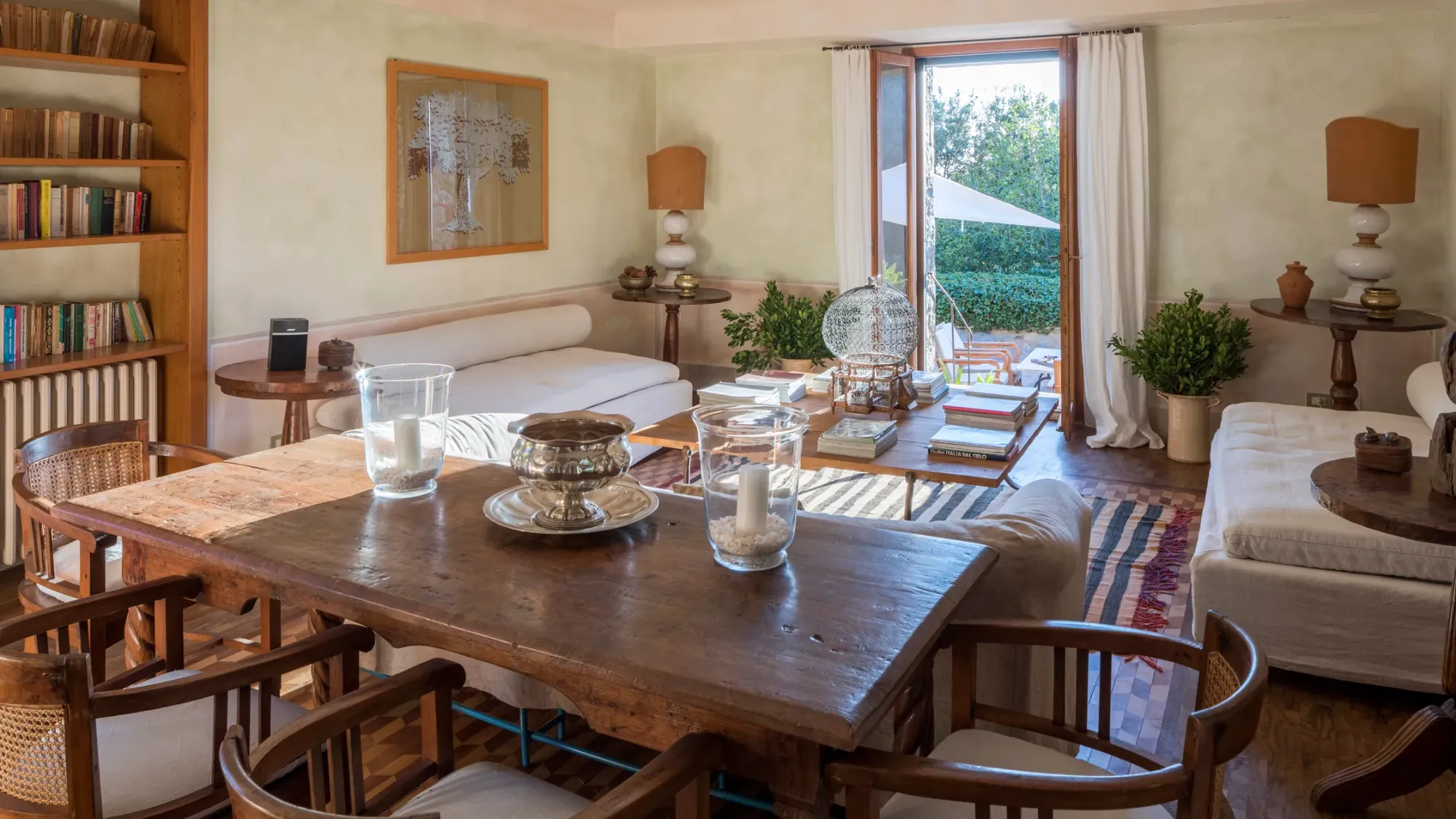
Tuscany, with its rolling vineyards and mediaeval towns, looks like a scene from a fairy tale, ready for you to enter its fantasy world. It's a dream destination for any wine enthusiast, with well-known wines such as Chianti and Brunello. Imagine walking through Florence's small cobblestone lanes, gazing up at towering cathedrals and palazzos. And let us not forget about the food! Tuscan cuisine is an unbelievable experience. So, why wait? Come experience the charm of Tuscany and create memories to last a lifetime.
Best Hotels in Tuscany

Belmond Villa San Michele
Belmond Villa San Michele
The location, on a calm, forested hillside just below the historic village of Fiesole less than five miles north of Florence's centre, gets my vote, but it's around a 20-minute drive from the main attractions. Although there is a regular shuttle service, it may not fit everyone.
However, the sweeping views of the city from the gardens, most of the rooms, the restaurant, and the pool are spectacular, and the temperature up here is several degrees cooler during the height of summer.

Belmond Villa San Michele
The hotel emphasises controlled excellent taste above ostentatious luxury, while Africa, the GM's affable labrador, keeps things from becoming too stiff. It is located in a former Franciscan monastery from the 15th century (Michelangelo is claimed to have designed the weathered, porticoed façade).
The main building, a maze of rooms, hallways and stairways, has many ancient elements, including cloisters (now covered), huge arches and vaulted ceilings, a long loggia (now the main restaurant), and aged terracotta flooring.
Precious Florentine antiques, as well as old master paintings and prints, fit nicely in the historic rooms, but a recent delicate refurbishment (with the addition of some more contemporary furniture, fresh colours, and so on) has livened things up a bit.

Belmond Villa San Michele
As one would expect from a Belmond hotel, the services and facilities are excellent, including a well-known cookery school. The pristine, terraced gardens are a delight, and the panoramic pool, nestled in a verdant lawn at the top of the house, is a true advantage in hot weather and almost compensates for the lack of a spa, though there is now a 'wellness room' in the villa for massages and other treatments.
The little gym is open 24 hours a day, and there is a canopy in the garden where you may get a massage with a view. Cocktail workshops, wine tastings, trips to a cashmere manufacturer in Chianti, and rafting down the Arno River are among the many activities available.
The service is old-school, attentive, and courteous, and many of the employees (who will remember your name) have been here for years. There is a high level of attention to detail, such as personalised pillow cases for'special' guests.
The 22 rooms in the main building have an appropriately ecclesiastical atmosphere, but the monks would have scowled at the amenities on offer. Expect vaulted ceilings, bottle-glass window panes, and antique furniture, including some beautiful old bedsteads.

Belmond Villa San Michele
The 23 rooms in the garden annexes have less charm but greater space and large baths, and they are nonetheless exceedingly pleasant; each has a private garden of some kind. Each room has a Nespresso machine as well as tea and coffee trays.
The elegant yet lively main restaurant is housed under a long, vaulted loggia with views of the city, which is particularly spectacular at sunset.

Belmond Villa San Michele
The advent of young chef Alessandro Cozzolino in April 2019 breathed new life into the formerly staid menu, which now combines parts of Tuscany and his native Campania, as well as the occasional journey into Asia and beyond, with intriguing results.
Choose from traditional panzanella bread salad with amberjack ceviche and Jerez vinegar, Florentine 'lasagnette' with delicately smoked rabbit sauce and seasoned Tuscan cheese, or seared turbot with mango.

Casa Moricciani
Casa Moricciani
Castelmuzio, located on the boundary of Unesco World Heritage Site Val d'Orcia and only a 10-minute drive from Pienza, is a tiny counterpart of the famed Renaissance town (wonderful old town centre and great views), but without the swarms of visitors who accompany the former.
The village shop, bar and restaurant are all a two-minute walk from Casa Moricciani. Montisi, another picturesque village, is only a five-minute drive away. Wine aficionados could head farther afield to Montepulciano and Montalcino (30 minutes each), while Siena is an hour away.
The Italian owners had considered moving into the house themselves, and restoration work has been done with meticulous care, beginning with the recuperated wood beams and 18th-century terracotta floors (only the best would do for the former home of an Italian noble family).

Casa Moricciani
The interiors are in warm earthy tones, with exquisite wall paintings, antique fireplaces, and fresh flowers to complete the look. The exquisite country-style kitchen features a professional French stove and antique majolica tiles. Guests will also find a wicker basket filled with ceramic dinnerware ready to be taken out for a picnic.
Isabella Barlocher worked at Campari in Milan before falling in love with Carlo Moricciani, a Tuscan farmer from Pienza. The couple's combination of local knowledge and Milanese business acumen yields an impeccable, customised concierge service.
Guided excursions and cookery sessions at the family farm are essential. Two large leather-bound binders in the property contain recommendations for sightseeing, shopping, and restaurants (together with all necessary maps and GPS information).

Casa Moricciani
The garden is well maintained, providing idyllic settings for al fresco eating and sunset views from beneath the pergola. The freshwater plunge pool is a perfect location to unwind with an aperitif after a long day of touring.
The four bedrooms are accessed by repaired wooden doors. Unique objects, such as the old wrought-iron bedstead, complement the home's careful traditional decor.

Casa Moricciani
From linen curtains to bed throws, all textiles are acquired from top labels like Milan fashion company Etro or lovingly handcrafted by local artisans.
The bathrooms have magnificent travertine sinks and tubs with whirlpools or wide rain showers (check out the spectacular valley view from the first-floor shower); hair straighteners, hair dryers and copious samples of the family-owned Locherber natural bath and skin care products are provided.

Casa Moricciani
A self-catering basket may be pre-ordered and is well worth the cost (€25/£22). Fresh fruits and vegetables are served alongside local food like pasta, homemade bread, olive oil, and red wine. The temperature-controlled wine cabinet is stocked with Brunello, Vino Nobile, and other carefully chosen local wines.
La Locanda di Casal Mustia is a restaurant, café and bar in one. Located in the village's main plaza, this is an excellent place to grab a quick coffee, aperitif, lunch, or dinner. Local chefs can provide culinary workshops and dinners right in the villa.

Borgo Santo Pietro
Borgo Santo Pietro
Set in lovely countryside far from the beaten track, 45 minutes southwest of Siena and near to the historic roofless abbey of San Galgano. The property spans 300 acres of gardens, farming, and woodlands, and there are numerous activities available on-site, so many tourists remain for the duration.
If you want a taste of metropolitan culture, the charming cities of Volterra, Massa Marittima, and Colle Val d'Elsa are all within an hour's drive. For beachgoers, the coast is a little further. The nearest airport is Florence Peretola (about 90 minutes by driving).
The atmosphere at this country house hotel is similar to that of a classy friend's estate. Danish co-owner Jeanette Throttrup has managed every detail of the interior design, which is luxurious and exquisite with a distinct antique feel.

Borgo Santo Pietro
The main villa's public areas have working fireplaces (which crackle cheerfully in cool weather), rich earthy hues, leather and velvet, spectacular floral arrangements, antiques, and gilt mirrors; flickering lighting adds to the intimacy. It's a kind of Tuscan-style 'hygge'.
Although guests come here to enjoy a luxurious and exclusive country vacation (which BSP provides in spades), many leave truly amazed at the bigger picture, because the Throttrup's vision for Borgo is that it will one day be self-sufficient, and it is constantly evolving; the most recent additions include two new garden suites, a fermenting lab, a drying shed for herbs and flowers, vineyards, additional kitchen gardens, and an alpaca herd.
The extensive facilities include a fantastic spa that uses the estate's herbal Seed-to-Skin products, a stunning infinity pool, swimming in the River Merse, numerous lounging areas both inside and out, 13 acres of magnificent gardens, and two restaurants. That's not to mention the miles of hiking paths that wind across the property.

You can sign up for culinary, flower arranging, and art workshops, farm visits, beekeeping and cheese-making demonstrations, Vespa tours, and hot air balloon rides. There is a helipad and even a 41.5-metre yacht available for charter.
Pets are permitted in the garden suites (a one-time €30/£25 fee applies).
Super-helpful staff are all friendly and professional, and they will go out of their way to accommodate customers' every desire.

Borgo Santo Pietro
Each of the 22 bedrooms and suites is distinctive, yet they are all huge and extremely comfortable. The style is light and romantic, with vaulted ceilings and pale stone flooring, lovely paintings, antiques and dazzling chandeliers, nubbly Tuscan linens and rich velvets, and a soft, soothing colour palette. Mood lighting (managed by an unintuitive series of switches, it must be stated) and candles enhance the atmosphere.
The three massive, wonderful pool suites are the best of the group, with private pools and fireplaces both inside and out, but the garden suites are also stunning and ideal for anyone seeking isolation.
The main villa has eight rooms, including the spacious first-floor Santo Pietro Suite, which has a huge terrace and panoramic views.

Borgo Santo Pietro
Enveloping beds have the finest Egyptian cotton sheets, feather duvets, and layers of plush pillows. Bathrooms are as fantastic as you'd hope, with honey-hued stone, double basins, big walk-in showers and claw-foot tubs, piles of fluffy towels, and generous amounts of the divine in-house Seed to Skin bath and body products.
All rooms come equipped with fully loaded iPads and DVD players, in addition to the standard flat-screen televisions.
The menus in the two restaurants are driven by a committed farm-to-table ethos; the vast kitchen garden and farm supply just-picked fruit, vegetables, and herbs, fresh eggs from the galline (who live in luxury in a row of pastel-colored coops), honey from the bees, cheeses from the sheep (processed in the in-house dairy), rabbit, fallow deer, and wild boar.
At Michelin-starred Meo Modo, where farm-to-plate is the driving idea, the chef accomplishes extraordinary things with the estate's bounty, focusing primarily on vegetables. Seafood also plays a role, with plenty of lobster, amberjack, and sea bass from the adjacent Tyrrhenian Sea.
The more casual Trattoria sul Albero is a fantastic space: a treehouse built around the enormous trunk of an ancient oak tree. Tuna tartare with guacamole, ricotta and spinach-stuffed cappelletti, grilled fish and bistecca, and delicious wood-fired pizza are all available here. The regular Monday night 'Farmer's Market' dinners with live jazz are quite popular; there is a self-serve buffet to begin, followed by meat or fish grilled to order.

Borgo Santo Pietro
A delicious breakfast is offered until 11 a.m. (albeit it's a moveable feast); in addition to a buffet table brimming with sweet and savoury treats, staff will whip up bacon and sausage, eggs Florentine or Benedict, omelettes, pancakes any way they want at the breakfast counter.

Castello di Vicarello
Castello di Vicarello
The off-the-grid location, at the end of a bumpy gravel route deep in the southern Maremma, cannot be beat if you want to entirely unplug and relax, yet there is culture within a 40-minute drive.
Rising squarely from a hilltop perch and guarded by soldier-straight cypress trees, the 12th-century stone castle and outbuildings are surrounded on all sides by the most glorious views of the Ombrone valley, with its thickly forested hills, vines, and olive trees, plus the odd stone farmhouse; the outline of Monte Argentario and a hazy strip of sea can be seen to the west.

Castello di Vicarello
The little village of Cinigiano is only a 10-minute drive away, while Siena and the Argentario beaches are 40 minutes apart. The main roadway connecting Siena and Grosseto is a 20-minute trip. The nearest airport is Florence Peretola (one hour and 40 minutes by vehicle), while a train from Grosseto (a 20-minute drive) takes less than two hours to Rome.
Aurora and Carlo Baccheschi Berti purchased the wrecked castle in the 1970s and began a comprehensive repair. Initially, it served as a home for family and friends, but it was later converted into a hotel with the feel of a quirky - but extremely charming - party house.

Castello di Vicarello
Today, it is in the capable hands of their three sons, Brando, Neri, and Corso, who have improved the amenities and service while preserving the essence of this unique hideaway.
The style is eclectic and very personal: the atmospheric rooms are filled with a mix of Indonesian pieces (accumulated during the Baccheschi Berti's 20 years of living in Bali), Tuscan antiques, design classics from the 1960s and 1970s purchased at auction, and a haul of family china, glassware, paintings, oriental rugs, and curiosities. Coffee tables are piled high with books and periodicals, ideal for spending a cool afternoon in front of a roaring fire.
The charming young personnel are friendly and helpful, and they will do everything they can to ensure that your stay runs properly.

Castello di Vicarello
Uva, the soppy in-house lab mix, welcomes guests joyfully and contributes to the warm atmosphere of the establishment. Wine tastings, hands-on culinary classes, riding lessons, and leather crafts with a local artisan are among the many activities available.
Free E-bikes and a vintage Fiat 500 (for an additional fee) are available for tours throughout the countryside. For only nine suites, there is a tremendous amount of space, including lovely rambling gardens with immaculate grass, a large vegetable plot, plenty of shady, isolated seating spots, two fabulous pools (one heated) with spectacular views, and walking and bicycling trails among the wooded hills.
Among the olive trees is a wood and glass spa suite; future plans include a gym as well as a full spa with sauna and steam room.
Dogs are welcome (additional daily charge) and will be provided with a bed and a welcome pack of treats.

